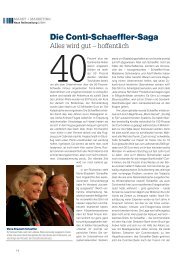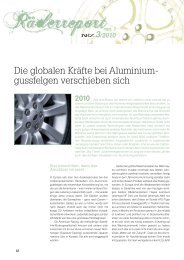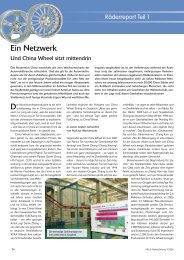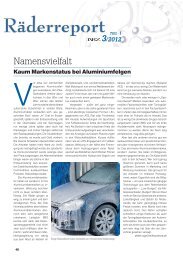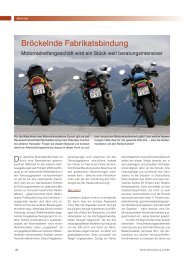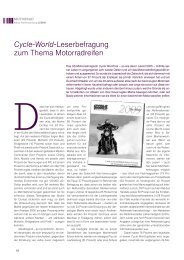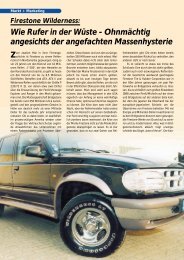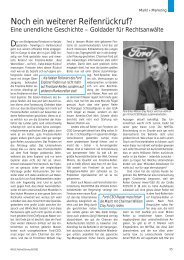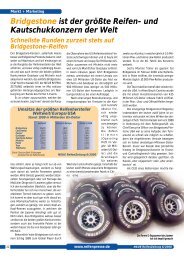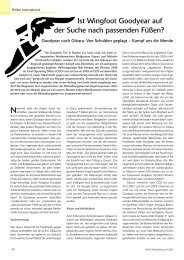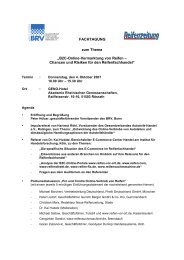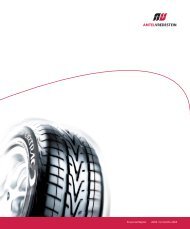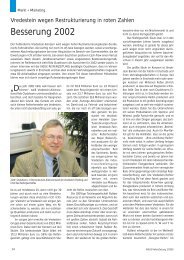Layout 1 (Page 1) - Reifenpresse.de
Layout 1 (Page 1) - Reifenpresse.de
Layout 1 (Page 1) - Reifenpresse.de
Erfolgreiche ePaper selbst erstellen
Machen Sie aus Ihren PDF Publikationen ein blätterbares Flipbook mit unserer einzigartigen Google optimierten e-Paper Software.
agreement that Bridgestone took over<br />
Bandag because it was interested in the<br />
leading position of Bandag <strong>de</strong>alers in the<br />
North American truck tyre market; the acquisition<br />
wasn’t induced by Europe.<br />
According to Joe Krimpenfort Michelin<br />
is the only new tyre manufacturer<br />
“that un<strong>de</strong>rstands the whole culture of<br />
retreading.” The French tyre giant is a<br />
clear market lea<strong>de</strong>r in the combined<br />
European pre-cured and mould-cured<br />
retreading market with its two brands<br />
Remix (mould-cured) and Recamic (precured).<br />
Statistics show that Michelin has<br />
a combined market share of about 30 per<br />
cent. But Michelin’s production partners<br />
only produce up to five per cent of all<br />
Europe’s retrea<strong>de</strong>d truck tyres using<br />
Recamic pre-cured treads. Michelin retreads<br />
are foremost Remix mould-cured<br />
retreads produced by Michelin itself and<br />
then, a distant second, Recamic.<br />
Attempts by other new tyre manufacturers<br />
such as Goodyear-Dunlop (Next<br />
Tread), Continental (ContiTread and Contire)<br />
or Pirelli (Novateck) to secure a foothold<br />
in the European retreading market<br />
have all been induced out of necessity,<br />
believes Mr Krimpenfort, who also worked<br />
for Goodyear-Dunlop for 14 years (as<br />
managing director, Benelux). “They cannot<br />
afford to be absent, and the market<br />
forces them to be committed to retreading.”<br />
First of all, companies like those<br />
mentioned above have wanted to sell<br />
their new tyres. And only as a second<br />
step have they also offered retreading<br />
services and retreads in or<strong>de</strong>r to keep<br />
their valuable casings in the value-ad<strong>de</strong>d<br />
process of their own corporate systems.<br />
Whether material suppliers from the<br />
so-called “second row” will actually benefit<br />
from a growth taking place in the<br />
European retreading market appears to<br />
be uncertain – the reason for this: there is<br />
no such <strong>de</strong>velopment; the European retreading<br />
market is barely <strong>de</strong>veloping at<br />
all, at least not in regards to its size. As it<br />
appears, this situation will not change<br />
fundamentally in the foreseeable future.<br />
In turn, if these second row companies<br />
gain market share in the European<br />
retreading market they do so because<br />
they succeed in what appears to be intense<br />
cut-throat competition. Currently,<br />
about 7.5 million truck tyres are retrea<strong>de</strong>d<br />
Pre-cured Retreading in the EU – Market Shares<br />
Kaltrun<strong>de</strong>rneuerung in <strong>de</strong>r EU – Marktanteile<br />
2000<br />
Michelin<br />
2004<br />
Others/An<strong>de</strong>re<br />
18%<br />
Kraiburg<br />
Others/An<strong>de</strong>re<br />
23%<br />
Michelin<br />
Marangoni inkl.<br />
Ellerbrock<br />
2005<br />
Others/An<strong>de</strong>re<br />
29%<br />
Michelin<br />
2007<br />
Kraiburg<br />
Others/An<strong>de</strong>re<br />
34%<br />
2010<br />
Michelin<br />
6%<br />
9%<br />
6%<br />
Others/An<strong>de</strong>re<br />
20%<br />
4%<br />
20%<br />
Kraiburg<br />
20%<br />
20%<br />
23%<br />
Bandag<br />
33%<br />
Marangoni inkl.<br />
Ellerbrock<br />
Bandag<br />
27%<br />
21%<br />
Kraiburg<br />
Marangoni inkl.<br />
Ellerbrock<br />
23%<br />
22%<br />
Bandag<br />
Marangoni inkl.<br />
Ellerbrock<br />
26%<br />
16%<br />
50% ?50%<br />
Bandag<br />
Source/Quelle: various/verschie<strong>de</strong>ne<br />
Tyres & Accessories/NEUE ReifenZeitung 9/2006<br />
me von Bandag einen Marktanteil von <strong>de</strong>rzeit<br />
noch knapp 20 Prozent in Europa gesichert.<br />
Was Bridgestone daraus macht, könne <strong>de</strong>rzeit<br />
ebenfalls nicht mit Sicherheit gesagt<br />
wer<strong>de</strong>n. Die Verantwortlichen in <strong>de</strong>r europäischen<br />
Bridgestone-Zentrale in Belgien<br />
sind gegenwärtig intensiv damit beschäftigt,<br />
die Bandag-Integration zu vollziehen und zu<br />
klären, wie Bridgestone in Europa genau aus<br />
<strong>de</strong>r Akquisition Profit schlagen will. Offizielle<br />
Stellungnahmen dazu gibt es <strong>de</strong>rzeit noch<br />
nicht. Die Übernahme Bandags – da sind sich<br />
alle Beobachter einig – hat zunächst einmal<br />
<strong>de</strong>n US-amerikanischen Markt zum Ziel.<br />
Michelin – laut Joe Krimpenfort <strong>de</strong>r einzige<br />
Neureifenhersteller, <strong>de</strong>r eine eigene „tragfähige<br />
Run<strong>de</strong>rneuerungsphilosophie“ besitzt<br />
– ist mit seinen Marken Remix (werkseigene<br />
Heißrun<strong>de</strong>rneuerung) und Recamic (Kalterneuerung)<br />
mit großem Abstand Marktführer<br />
auf <strong>de</strong>m Gesamtmarkt mit einem Marktanteil<br />
von rund 30 Prozent. Betrachtet man aber nur<br />
<strong>de</strong>n europäischen Markt für Kaltrun<strong>de</strong>rneuerungen,<br />
so kann Michelin mit seinem Recamic-Verfahren<br />
europaweit seit Jahren einen<br />
Marktanteil von nur – muss man fast sagen –<br />
um die fünf Prozent für sich behaupten.<br />
Michelin-Run<strong>de</strong>rneuerte, das sind zunächst<br />
Remix-Heißrun<strong>de</strong>rneuerte.<br />
Die Versuche <strong>de</strong>r an<strong>de</strong>ren großen Neureifenhersteller<br />
wie Goodyear-Dunlop (Next<br />
Tread), Continental (ContiTread und Contire)<br />
o<strong>de</strong>r Pirelli (Novateck), im Run<strong>de</strong>rneuerungsmarkt<br />
Fuß zu fassen, seien aus <strong>de</strong>r puren Notwendigkeit<br />
heraus entstan<strong>de</strong>n, meint Joe<br />
Krimpenfort, <strong>de</strong>r ebenfalls 14 Jahre für Goodyear-Dunlop<br />
(u.a. als Geschäftsführer Benelux)<br />
gearbeitet hatte. „Sie können es sich<br />
nicht leisten, nichts zu tun. Der Markt zwingt<br />
sie dazu, etwas in Sachen Run<strong>de</strong>rneuerung<br />
zu tun.“ All die oben genannten Unternehmen<br />
wollten zunächst einmal Neureifen verkaufen,<br />
bieten aber auch run<strong>de</strong>rneuerte Reifen an, um<br />
ihre wertvollen Karkassen im Wertschöpfungsprozess<br />
<strong>de</strong>s eigenen Unternehmens zu<br />
halten.<br />
Dass Materiallieferanten aus <strong>de</strong>r so genannten<br />
zweiten Reihe von einer <strong>de</strong>utlichen<br />
Entwicklung <strong>de</strong>s Gesamtmarktes in Europa<br />
profitieren können, scheint eher ungewiss,<br />
<strong>de</strong>nn eine solche „<strong>de</strong>utliche“ Entwicklung<br />
wird es nicht geben. Sie gewinnen Marktanteile<br />
über einen hart geführten Verdrängungswettbewerb.<br />
Europaweit wer<strong>de</strong>n <strong>de</strong>rzeit jährlich<br />
etwa 7,5 Millionen Lkw-Reifen heiß- und<br />
kalterneuert. Dabei liegt <strong>de</strong>r Kaltrun<strong>de</strong>rneue-<br />
11



